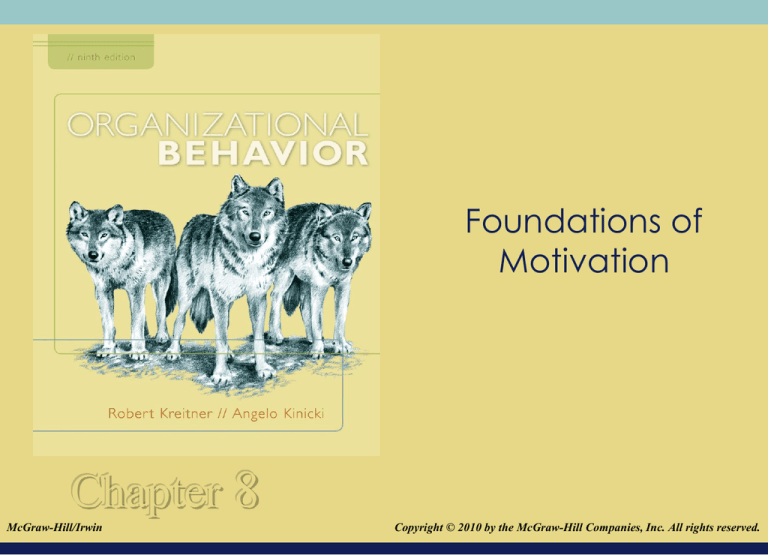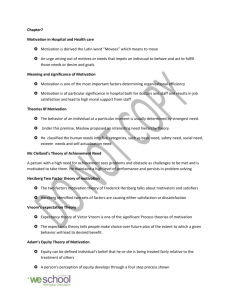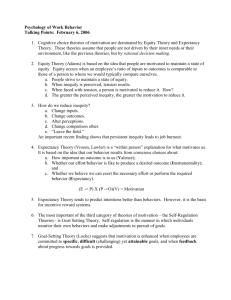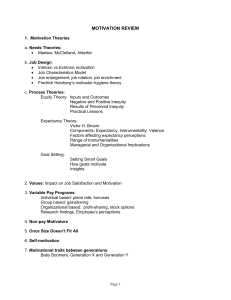
Foundations of
Motivation
Chapter 8
McGraw-Hill/Irwin
Copyright © 2010 by the McGraw-Hill Companies, Inc. All rights reserved.
© 2008The McGraw-Hill Companies, Inc. All rights reserved.
Ch. 8 Learning Objectives
1. Contrast Maslow’s, Alderfer’s, and McClelland’s
need theories.
2. Explain the practical significance of Herzberg’s
distinction between motivators and hygiene factors.
3. Discuss the role of perceived inequity in employee
motivation.
4. Explain the differences among distributive,
procedural, and interactional justice.
5. Describe the practical lessons derived from equity
theory.
8-2
Ch. 8 Learning Objectives
6. Explain Vroom’s expectancy theory and review its
practical implications., racial and ethnic, and
disability stereotypes.
7. Explain how goal setting motivates an individual
and review the four practical lessons from goalsetting research.
8. Review the mechanistic, motivational, biological,
and perceptual-motor approaches to job design.
8-3
Motivation
Motivation
psychological processes
that arouse and direct
goal-directed behavior
Does high motivation
mean better job
performance?
• A=Yes, B=No
Is money the only
motivator?
8-4
Theories of Motivation
Content Theories
• Identify internal factors
influencing motivation
Maslow’s Need
Hierarchy
Alderfer’s ERG
McClelland’s Need
Herzberg’s MotivatorHygiene
Process Theories
• Identify the process
by which internal
factors and
cognitions influence
motivation
Adam’s Equity
Vroom’s
Expectancy
Goal Setting Theory
8-5
Motivation Theories
8-6
Maslow’s Need Hierarchy Theory
How does the
theory work?
What research
support does this
theory have?
What are the
managerial
implications of this
theory?
8-7
Employee’s Varying Needs
8-8
Alderfer’s ERG Theory
Existence: Desire for
physiological and
materialistic well-being
Relatedness: Desire to
have meaningful
relationships with
significant others
Growth: Desire to
grow and use one’s
abilities to their fullest
potential
How does this theory
work?
What is the research
support?
What are the
managerial
implications?
8-9
McClelland’s Need Theory
The Need for
Achievement
• Desire to accomplish
something difficult
The Need for
Affiliation
• Desire to spend time
in social relationships
and activities
The Need for Power
• Desire to influence,
coach, teach, or
encourage others to
achieve
8-10
McClelland’s Needs Theory in Practice
1. Is high need for power good or bad?
A= Good, B=Bad, C= It depends
2. What is the most important need for leaders?
a. Achievement
b. Affiliation
c. Power
3. What is the least important?
a. Achievement
b. Affiliation
c. Power
8-11
Test Your Knowledge
A manager made the following work assignments
based on her perception of her employee’s needs.
Sam – responsible for orienting new employees to
the team; Rex – responsible for operations of an
entire division; Jose – researcher in R & D. Which of
the following set of pairs below is probably true?
a. Sam- power; Rex- achievement; Jose- affiliation;
b. Sam – affiliation; Rex- power; Jose – achievement
c. Sam – achievement, Rex – affiliation, Jose – power
d. Sam – achievement; Rex – power; Jose - affiliation
8-12
Herzberg’s Motivator-Hygiene Model
Hygiene Factors job characteristics associated with
job dissatisfaction
• Salary
• Supervisory relations
• Working conditions
Motivators job characteristics associated with job
satisfaction
• Achievement
• Recognition
• Responsibility
8-13
Herzberg’s Motivator-Hygiene Model
Basic premise: Job satisfaction is not a
continuum from satisfied to dissatisfied
Rather, there are two continuums
•No Satisfaction …… Satisfaction
•Dissatisfaction ……No dissatisfaction
8-14
Herzberg’s Motivator-Hygiene
Model
8-15
Comparison of Content Theories of
Motivation
Needs Hierarchy
Theory
SelfActualization
ERG
Theory
Growth
Esteem
Belongingness
Relatedness
McClelland’s
Motivator--Hygiene
Learned Needs
Theory
Need for
Achievement
Need for
Power
Motivators
Need for
Affiliation
Hygienes
Safety
Existence
Physiological
8-16
Equity Theory
Equity theory – people strive for fairness and justice
in social exchanges
People will be motivated to the extent their
perceived inputs to outcomes is in balance
A. Compare personal outcomes to inputs.
B. Compare your outcomes to relevant others:
1. Comparisons to teammates or coworkers
2. Comparisons to another group (e.g.
department/unit)
3. Comparisons to others in your field or occupational.
8-17
Equity Theory
A. An Equitable Situation
Other
Self
$2
= $2 per hour
1 hour
$4
= $2 per hour
2 hours
8-18
Equity Theory
B. Negative Inequity
Self
$2
= $2 per hour
1 hour
Other
$3
1 hour
= $3 per hour
8-19
Equity Theory
C. Positive Inequity
Other
Self
$3
= $3 per hour
1 hour
$2
= $1 per hour
1 hours
8-20
Test Your Knowledge
Deena works 60 hours per week and does not feel
that she is being adequately recognized or rewarded.
According to equity theory, Deena is least likely to:
a. Ask for a raise or bonus
b. Reduce her efforts by decreasing her hours
c. Increase her efforts by working longer hours
d. Frame the situation as a learning experience and
beneficial for her future career.
8-21
For Discussion: Assess Yourself –
Equity Sensitivity
Which of the following best describes you? In most
situations, I…
a. put in more than I get out, which is fine with me
b. typically strive for equity and fairness in terms of
my inputs and outcomes (even if I feel positive
inequity)
c. try to put in as little effort as possible to attain
desired rewards
8-22
Equity Sensitivity
Equity Sensitivity an individual’s
tolerance for negative and positive
equity
• Benevolents have a higher tolerance for
negative inequity
• Sensitives adhere to strict norm of reciprocity
• Entitleds have no tolerance for negative inequity
8-23
Organizational Justice
Distributive Justice the
perceived fairness of how
resources and rewards are
distributed
Procedural Justice the
perceived fairness of the
process and procedure used to
make allocation decisions
Interactional Justice
extent to which people feel
fairly treated when procedures
are implemented
8-24
Lessons From Equity Theory & Justice
What important work-related
variables are perceptions of equity
related to?
What are the managerial
implications of equity theory and
organizational justice research?
8-25
Expectancy Theory of Motivation
E-to-P
Expectancy
Outcomes
P-to-O
Instrumentality & Valences
Outcome 1
+ or -
Effort
Performance
Outcome 2
+ or -
Outcome 3
+ or -
8-26
Test Your Knowledge
For each of the following actions, indicate which part
of the expectancy model, specifically, would be
improved for an unmotivated employee?
A. Effort to Performance (Expectancy)
B. Performance to Outcome (Instrumentality)
C. Value of rewards (Valence)
1.
2.
3.
4.
5.
Show direct link between performance and raises.
Set clear goals, establish positive expectations
Base rewards on what the employee values.
Establish a pay for performance plan.
Provide adequate resources and training.
8-27
Implications of Expectancy Theory
8-28
Goal-Setting Theory
Goal what an
individual is
trying to
accomplish
8-29
Locke’s Model of Goal Setting
Directing
one’s attention
Regulating
one’s effort
Goals
motivate the
individual
by...
Task
performance
Increasing
one’s persistence
Encouraging the
development of goalattainment strategies
or action plans
8-30
Guidelines for SMART Goals
Specific
Measurable
Attainable
Results oriented
Time bound
Give feedback regularly!
8-31
Test Your Knowledge
True (A) or False (B)?
1) “Do your best” goals maximize performance
2) Feedback enhances the effect of specific, difficult
goals
3) Participative goals, assigned goals, and self-set goals
are equally effective
4) Goal commitment affects goal-setting outcomes
5) Monetary incentives for goals always improve goalsetting outcomes
8-32
Job Design Approaches to Motivation
Job Design: Changing the content or process
of a specific job to increase job satisfaction
and performance
Motivational strategies:
Job Rotation moving employees from one
specialized job to another
Job Enlargement putting more variety into a job
Job Enrichment building achievement, recognition,
responsibility, and advancement into the work
8-33
The Job Characteristics Model
Core
job
characteristics
Critical
psychological
state
Outcomes
Skill variety
Task identity
Task significance
Experienced
meaningfulness of
work
High intrinsic
work motivation
Autonomy
Experienced
responsibility for
outcomes of the
work
High growth
satisfaction
High general job
satisfaction
Feedback from
job
Knowledge of the
actual results of
the work activities
High work
effectiveness
1.
2.
3.
Moderators
Knowledge and skill
Growth need strength
Context satisfaction
8-34
Applying Job Characteristics Model
Steps for applying the job characteristics model
8-35







